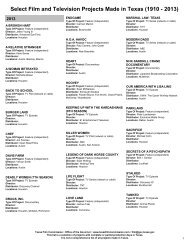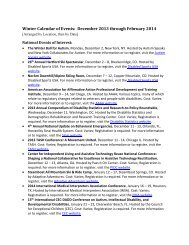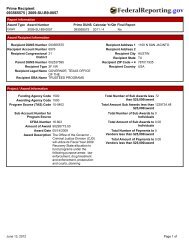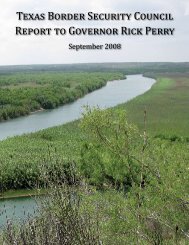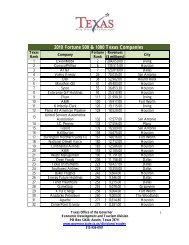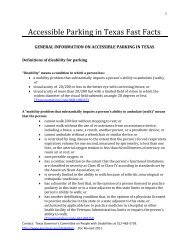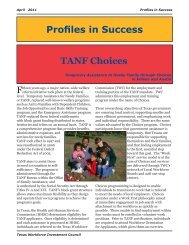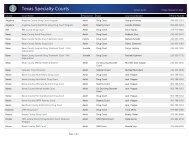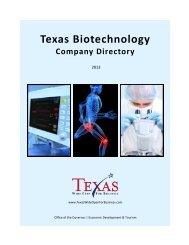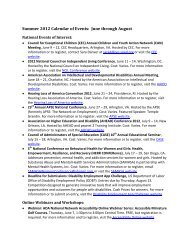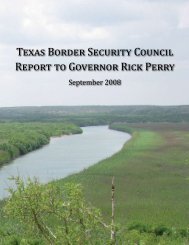CJD FUNDING SOURCES
CJD FUNDING SOURCES
CJD FUNDING SOURCES
You also want an ePaper? Increase the reach of your titles
YUMPU automatically turns print PDFs into web optimized ePapers that Google loves.
STATE FUNDS ADMINISTERED BY THE<br />
GOVERNOR’S CRIMINAL JUSTICE DIVISION<br />
IN FISCAL YEAR 2006 1 :<br />
Criminal Justice Planning Fund (Fund 421)<br />
Source: A biennial appropriation by the Texas<br />
Legislature from funds collected through court<br />
costs and fees. Texas Code of Criminal<br />
Procedure, §102.056 and §102.075. Section<br />
772.006 of the Texas Government Code<br />
designates <strong>CJD</strong> as the Fund's administering<br />
agency.<br />
FY Appropriation: $25,691,837<br />
Purpose: Support a wide range of projects<br />
designed to reduce crime and improve the<br />
criminal and juvenile justice systems.<br />
Eligibility: State agencies, units of local<br />
government, independent school districts,<br />
nonprofit corporations, Native American tribes,<br />
COGs, universities, colleges, hospital districts,<br />
juvenile boards, regional education service<br />
centers, community supervision and<br />
corrections departments, crime control and<br />
prevention districts, and faith-based<br />
organizations are eligible to apply for grants<br />
under this fund. Faith-based organizations<br />
must be certified by the Internal Revenue<br />
Service as tax-exempt nonprofit entities.<br />
Grantees may not use grant funds or program<br />
income for proselytizing or sectarian worship.<br />
Award Criteria: Meet the criteria codified in<br />
the TAC, Title 1, Part 1, Chapter 3, Subchapter<br />
C, Division 1<br />
Frequency of Award: Annual<br />
Drug Court Program<br />
Source: General Appropriations Act, 2004-<br />
2005 Biennium, Article I, Trusteed Programs<br />
Within the Office of the Governor, Strategy<br />
A.1.3., Rider 9; Chapter 469, Texas Health and<br />
Safety Code; House Bill 1287, 77 th Texas<br />
Legislature<br />
FY Appropriation: $750,000<br />
Purpose: Supports projects that provide<br />
court-supervised substance abuse treatment as<br />
an alternative to traditional criminal sanctions,<br />
as defined in Chapter 469 of the Texas Health<br />
and Safety Code.<br />
Eligibility: Texas counties<br />
Award Criteria: Projects must adhere to<br />
criteria and requirements in the Request for<br />
Applications as posted in the Texas Register.<br />
1 State funds are appropriated by the Texas Legislature for<br />
the purposes described. Funds available for award are<br />
contingent upon actual collections.<br />
<strong>CJD</strong> <strong>FUNDING</strong> <strong>SOURCES</strong><br />
Frequency of Award: Annual<br />
County Essentials Program<br />
Source: General Appropriations Act, Trusteed<br />
Programs within the Office of the Governor,<br />
Strategy A.1.7.<br />
FY Appropriation: $500,000<br />
Purpose: Provide financial assistance to Texas<br />
counties for essential public services including<br />
law enforcement services, jail services, court<br />
services, or reimbursement of extraordinary<br />
costs incurred for the investigation or<br />
prosecution of a capital murder or crimes<br />
committed because of bias or prejudice.<br />
Eligibility: Texas counties<br />
Award Criteria: Projects must adhere to<br />
criteria and requirements in the published<br />
Application Instruction Kit.<br />
Frequency of Award: Not Applicable<br />
Crime Stoppers Assistance Fund (Fund<br />
5012)<br />
Source: A biennial appropriation by the Texas<br />
Legislature established by the Texas Code of<br />
Criminal Procedure Article 102.013.<br />
FY Appropriation: $475,000<br />
Purpose: Enhance and assist community<br />
efforts in solving crimes<br />
Eligibility: Crime Stoppers organizations as<br />
defined by Chapter 414.001 of the Texas<br />
Government Code that are certified by the<br />
Crime Stoppers Advisory Council to receive<br />
repayments under Articles 37.073 and 42.152<br />
of the Texas Code of Criminal Procedure, or<br />
payments from a defendant under Article<br />
42.12 of the Texas Code of Criminal Procedure.<br />
Award Criteria: Meet the criteria codified in<br />
the TAC, Title 1, Part 1, Chapter 3, Subchapter<br />
C, Division 6.<br />
Frequency of Award: Annual<br />
O FFICE OF THE G OVERNOR C RIMINAL J USTICE D IVISION<br />
1
FEDERAL FUNDS ADMINISTERED BY THE<br />
GOVERNOR’S CRIMINAL JUSTICE DIVISION<br />
FISCAL YEAR 2006 2 :<br />
Byrne Justice Assistance Grants 3<br />
Source: U.S. Department of Justice<br />
CFDA Number: 16.738<br />
State Award: $ 14,045,713<br />
Purpose: Supports state and local law<br />
enforcement agencies addressing violent<br />
crime—including drug enforcement and<br />
criminal enterprise. Additionally, supports<br />
statistically supported strategies of<br />
enforcement at the local level.<br />
Eligibility: State agencies, units of local<br />
government, crime control and prevention<br />
districts, and Indian tribes that perform law<br />
enforcement functions (as determined by the<br />
Secretary of the Interior) are eligible to apply<br />
for grants under this fund.<br />
Award Criteria: Projects must adhere to<br />
criteria and requirements outlined within the<br />
Application Instruction Kit.<br />
Frequency of Award: Annual<br />
Hurricane Relief Fund<br />
Source: U.S. Department of Justice<br />
CFDA Number: 16.738<br />
State Award: $20,000,000<br />
Purpose: Improve the capability of public<br />
safety agencies to address violent crime and<br />
accommodate increased demands on law<br />
enforcement and emergency services<br />
Eligibility: Harris County, Fort Bend County,<br />
and City of Houston.<br />
Award Criteria: One time award<br />
Residential Substance Abuse Treatment<br />
Program<br />
Source: U.S. Department of Justice<br />
CFDA Number: 16.593<br />
State Award: $991,911<br />
Purpose: Develop and implement residential<br />
substance abuse treatment projects within<br />
state and local correctional facilities and jailbased<br />
substance abuse projects within jails<br />
and local correctional facilities.<br />
Eligibility: State agencies and counties that<br />
operate secure correctional facilities, and<br />
community supervision and corrections<br />
departments.<br />
Award Criteria: Adhere to criteria established<br />
2 Award amounts from federal funding sources are the<br />
amount allocated to the State of Texas for the federal fiscal<br />
year.<br />
3 Federal legislation combined the Edward Byrne Memorial<br />
Fund and the Local Law Enforcement Block into the Edward<br />
Byrne Memorial Justice Assistance Grants, or JAG, program<br />
for 2005.<br />
in the Texas Administrative Code, Title 1, Part<br />
1, Chapter 3, Subchapter C, Division 11.<br />
Frequency of Award: Annual<br />
Coverdell Grant Program<br />
Source: U.S. Department of Justice<br />
CFDA Number: 16.560<br />
State Award: $779,670<br />
Purpose: Improve the quality, timeliness, and<br />
credibility of forensic science services for<br />
criminal justice purposes.<br />
Eligibility: State agencies and units of local<br />
government that operate the following: (1)<br />
laboratories currently accredited by the<br />
Laboratory Accreditation Board of the American<br />
Society of Crime Laboratory Directors, the<br />
National Association of Medical Examiners, or<br />
other appropriate accrediting bodies; or(2)<br />
unaccredited laboratories that are in the<br />
process of obtaining accreditation.<br />
Award Criteria: Adhere to requirements<br />
codified in the Texas Administrative Code, Title<br />
1, Part 1, Chapter 3, Subchapter C, Division<br />
13.<br />
Frequency of Award: Annual<br />
Victims of Crime Act Fund<br />
Source: U.S. Department of Justice<br />
CFDA Number: 16.575<br />
State Award: $28,340,000<br />
Purpose: Provide services that: (1) respond<br />
to the emotional and physical needs of crime<br />
victims; (2) assist victims in stabilizing their<br />
lives after victimization; (3) assist victims to<br />
understand and participate in the criminal<br />
justice system; and (4) provide victims with<br />
safety and security.<br />
Eligibility: (a) The following applicants are<br />
eligible to apply for grants under this fund:<br />
state agencies; units of local government;<br />
hospital districts; nonprofit corporations;<br />
Native American tribes; crime control and<br />
prevention districts; universities; colleges;<br />
community supervision and corrections<br />
departments; COGs that provide direct<br />
services to victims; faith-based organizations<br />
that provide direct services to victims of crime;<br />
and hospitals and emergency medical facilities<br />
that offer crisis counseling, support groups,<br />
and/or other types of victim services. Faithbased<br />
organizations must be certified by the<br />
Internal Revenue Service as tax-exempt<br />
nonprofit entities. Grantees may not use grant<br />
funds or program income for proselytizing or<br />
sectarian worship. In-patient treatment<br />
facilities, such as those designated to provide<br />
treatment to individuals with drug, alcohol, or<br />
mental health-related conditions, are not<br />
O FFICE OF THE G OVERNOR C RIMINAL J USTICE D IVISION<br />
2
eligible to apply for grant funds.<br />
(b) All applicants must: (1) Demonstrate a<br />
record of providing effective services to crime<br />
victims. If the applicant cannot yet<br />
demonstrate a record of providing effective<br />
services, the applicant must demonstrate that<br />
at least 25 percent of its financial support<br />
comes from non-federal sources. (2) Use<br />
volunteers, unless <strong>CJD</strong> determines that a<br />
compelling reason exists to waive this<br />
requirement. (3) Promote community efforts<br />
to aid crime victims. Applicants should<br />
promote, within the community, coordinated<br />
public and private efforts to aid crime victims.<br />
Coordination efforts qualify an organization to<br />
receive VOCA funds, but are not activities that<br />
can be supported with VOCA funds. (4) Assist<br />
victims in applying for crime victims’<br />
compensation benefits. (5) Maintain civil<br />
rights information. This requirement includes<br />
maintaining statutorily required civil rights<br />
statistics on the race, national origin, sex, age,<br />
and disability of victims served, within the<br />
timeframe established by <strong>CJD</strong>. This<br />
requirement is waived when providing service,<br />
such as telephone counseling, where soliciting<br />
the information may be inappropriate or<br />
offensive to the crime victim. (6) Provide<br />
equal services to victims of federal crimes. (7)<br />
Provide grant-funded services at no charge to<br />
victims. Any deviation requires prior written<br />
approval by <strong>CJD</strong>. (8) Maintain the<br />
confidentiality of all client-counselor<br />
information and research data, as required by<br />
state and federal law. (9) Not discriminate<br />
against victims because they disagree with the<br />
way the state is prosecuting the criminal case.<br />
Award Criteria: Meet the criteria codified in<br />
the TAC, Title 1, Part 1, Chapter 3, Subchapter<br />
C, Division 5.<br />
Frequency of Award: Annual<br />
S.T.O.P. Violence Against Women Act Fund<br />
Source: U.S. Department of Justice<br />
CFDA Number: 16.588<br />
State Award: $ 7,485,230<br />
Purpose: Assist in developing and<br />
strengthening effective law enforcement and<br />
prosecution strategies to combat violent crimes<br />
against women and to develop and strengthen<br />
victim services in such cases.<br />
Eligibility: State agencies, units of local<br />
government, nonprofit corporations, faithbased<br />
organizations, Indian tribal<br />
governments, COGs, universities, colleges,<br />
community supervision and corrections<br />
departments, and crime control and prevention<br />
districts are eligible to apply for grants under<br />
this fund. Faith-based organizations must be<br />
certified by the Internal Revenue Service as<br />
tax-exempt nonprofit entities. Grantees may<br />
not use grant funds or program income for<br />
proselytizing or sectarian worship.<br />
Award Criteria: Meet at least one of the<br />
eligible purpose areas established by the<br />
federal Violence Against Women Office and<br />
codified at 28 C.F.R. §90 and address at least<br />
one Texas priority codified in the TAC, Title 1,<br />
Part 1, Chapter 3, Subchapter C, Division 9.<br />
Frequency of Award: Annual<br />
Juvenile Accountability Block Grant<br />
Source: U.S. Department of Justice<br />
CFDA Number: 16.523<br />
State Award: $2,692,100<br />
Purpose: Develop programs that promote<br />
greater accountability in the juvenile justice<br />
system.<br />
Eligibility: (a) Twenty-five percent of this fund<br />
is available for state discretionary set-aside<br />
grants to state agencies, units of local<br />
government (including crime control and<br />
prevention districts), Native American tribal<br />
governments, COGs, nonprofit corporations,<br />
and faith-based organizations. Faith-based<br />
organizations must be certified by the Internal<br />
Revenue Service as tax-exempt nonprofit<br />
entities. Grantees may not use grant funds or<br />
program income for proselytizing or sectarian<br />
worship. Discretionary projects are eligible for<br />
funding only under the specific program<br />
purpose areas selected by the Governor’s<br />
Juvenile Justice Advisory Board from the<br />
program purpose areas listed in §3.1203 of<br />
this chapter.<br />
(b) Seventy-five percent of this fund is<br />
available for local/regional formula grants to<br />
cities and counties based on a formula<br />
combining juvenile justice expenditures for<br />
each unit of local government and the average<br />
annual number of Uniform Crime Report Part I<br />
violent crimes reported for each unit of local<br />
government for the three most recent calendar<br />
years for which data are available.<br />
(1) Cities and counties qualifying for a direct<br />
formula allocation of $10,000 or more will<br />
receive notice of such allocation.<br />
(2) Cities and counties that do not qualify for<br />
the $10,000 minimum local/regional formula<br />
allocation grants, Native American tribal<br />
governments, and COGs are eligible to apply<br />
for funding to benefit local governments in<br />
accordance with the most recent and valid RFA<br />
issued by <strong>CJD</strong>.<br />
Award Criteria: Meet the criteria established<br />
in the TAC, Title 1, Part 1, Chapter 3,<br />
O FFICE OF THE G OVERNOR C RIMINAL J USTICE D IVISION<br />
3
Subchapter C, Division 12.<br />
Frequency of Award: Annual<br />
Juvenile Justice and Delinquency<br />
Prevention Fund (Title II)<br />
Source: U.S. Department of Justice<br />
CFDA Number: 16.540<br />
State Award: $4,707,833<br />
Purpose: Develop more effective education,<br />
training, research, prevention, diversion,<br />
treatment, and rehabilitation programs in the<br />
area of juvenile delinquency and programs to<br />
improve the juvenile justice system.<br />
Eligibility: State agencies, units of local<br />
government, nonprofit corporations, Indian<br />
tribes performing law enforcement functions,<br />
crime control and prevention districts,<br />
universities, colleges, independent school<br />
districts, and faith-based organizations are<br />
eligible to apply for grants under this fund.<br />
Faith-based organizations must be certified by<br />
the Internal Revenue Service as tax-exempt<br />
nonprofit entities. Grantees may not use grant<br />
funds or program income for proselytizing or<br />
sectarian worship.<br />
Award Criteria: Address at least one priority<br />
area codified in the TAC, Title 1, Part 1,<br />
Chapter 3, Subchapter C, Division 2.<br />
Frequency of Award: Annual<br />
Safe & Drug-Free Schools & Communities<br />
Act Fund<br />
Source: U.S. Department of Education, Office<br />
for Safe and Drug Free Schools<br />
CFDA Number: 84.184<br />
State Award: $5,492,366<br />
Purpose: Implement the following drug and<br />
violence prevention services for youth and<br />
families who are not normally assisted by state<br />
or local education agencies: (1)<br />
complementing and supporting local<br />
educational agency activities, including<br />
developing and implementing activities to<br />
prevent and reduce violence associated with<br />
prejudice and intolerance; (2) disseminating<br />
information about drug and violence<br />
prevention; (3) developing and implementing<br />
community-wide drug and violence prevention<br />
planning and organizing; (4) fostering a safe<br />
and drug-free learning environment that<br />
supports academic achievement; (5)<br />
preventing and reducing violence; the use,<br />
possession and distribution of illegal drugs;<br />
and delinquency; (6) creating a well disciplined<br />
environment conducive to learning; and (7)<br />
promoting the involvement of parents.<br />
Eligibility: COGs, cities, counties,<br />
universities, colleges, independent school<br />
districts, nonprofit corporations, crime control<br />
and prevention districts, state agencies, Native<br />
American tribes, faith-based organizations,<br />
regional education service centers, community<br />
supervision and corrections departments, and<br />
juvenile boards are eligible for grants. Faithbased<br />
organizations must be certified by the<br />
Internal Revenue Service as tax-exempt<br />
nonprofit entities. These grantees may not use<br />
grant funds or program income for<br />
proselytizing or sectarian worship.<br />
Award Criteria: Meet the criteria codified in<br />
the TAC, Title 1, Part 1, Chapter 3, Subchapter<br />
C, Division 4.<br />
Frequency of Award: Annual<br />
Title V Grant Program<br />
Source: U.S. Department of Justice<br />
CFDA Number: 16.548<br />
State Award: $56,250<br />
Purpose: Reduce juvenile delinquency and<br />
youth violence by supporting communities in<br />
providing their children, families,<br />
neighborhoods, and institutions with the<br />
knowledge, skills, and opportunities necessary<br />
to foster a healthy and nurturing environment<br />
that supports the growth and development of<br />
productive and responsible citizens.<br />
Eligibility: Units of local government are<br />
eligible to apply for grants under this fund. For<br />
this fund, a unit of local government means<br />
any city, county, town, village, or other<br />
general purpose political subdivision of the<br />
state, and any Indian tribe which performs law<br />
enforcement functions as determined by the<br />
U.S. Secretary of the Interior.<br />
Award Criteria: Meet the criteria codified in<br />
the TAC, Title 1, Part 1, Chapter 3, Subchapter<br />
C, Division 3.<br />
Frequency of Award: Annual<br />
O FFICE OF THE G OVERNOR C RIMINAL J USTICE D IVISION<br />
4



